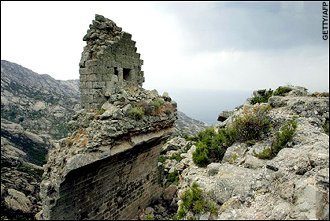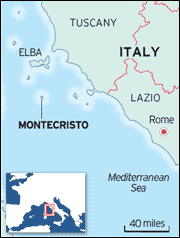
The tiny Tuscan island of Montecristo, whose mysterious history is filled with saints, monks and pirates, is to be opened up to the public for the first time.
The diamond-shaped island, which is around four square miles in size, was immortalised by Alexandre Dumas in The Count of Monte Cristo as the site of an enormous hidden treasure.
For almost 40 years, since it became a nature reserve, only scientists and researchers have been allowed within three miles of the island's granite cliffs.

The waters were regularly patrolled to make sure the island's population of monk seals, dolphins, tuna and rare birds was not disturbed.
Anyone entering the waters illegally was liable to an instant 150 pounds fine.
However, the Park Authority for the Tuscan Archipelago has now decided to allow up to 1,000 tourists a year to visit Montecristo, which lies 22 miles south of Elba and 40 miles from the coast of Italy.
Visitors will be allowed from April 1 to July 15 and then from August 31 to the end of October each year. Trips for 2009 have to be booked with the authority by the end of January next year.
Dumas arrived on the island in 1842, in the company of Napoleon Bonaparte's nephew.
"It is fantastic and lonely, smelling of thyme and broom," he wrote, in a letter.
He decided to write The Count of Monte Cristo to remind him of the trip.
His hero, Edmond Dantes, discovers a pirate's treasure on the island after being tipped off by his companion in prison, Abbe Faria.
Dumas described the island at midday: "Thousands of grasshoppers, hidden in the bushes, chirped with a monotonous and dull note; the leaves of the myrtle and olive trees waved and rustled in the wind.
"At every step that Edmond took he disturbed the lizards glittering with hues of emerald; afar off he saw the wild goats bounding from crag to crag."
Dumas was inspired by tales of a pirate's haul, buried in one of the island's grottos. In the 1550s, two pirates, Red Beard and Dragut, sacked the monastery on Montecristo and set up their base. Dragut, a Turk, is thought to have accumulated vast wealth and hidden his haul somewhere on the island.
However, no one has found it yet.
The island, which was named by St Mamiliano, the bishop of Palermo, after he fled there in the fifth century, has only been inhabited by a handful of people over the years.
The Romans named it Mons Jovis, and used the granite from its hills to build houses on Elba.
According to Roman mythology, Montecristo is one of seven "jewels" from the diadem of Venus that fell out when she bathed in the Tyrrhenian sea.
However, for most Italians, its nickname is "the island that doesn't exist", as almost no one has set foot upon it.
In the 19th century, it was owned by George Watson-Taylor, a rich British art collector.
Would-be tourists will have to sign up for a day of lectures before their visit to Montecristo.
"We will organise a lecture on the environment of the island the day before the trip," the president of the parks authority, Mario Tozzi, told the Corriere della Sera newspaper.
"Montecristo is an open-air museum and people who go there must understand what treasures they will see."
good news!!!
Thank you =)